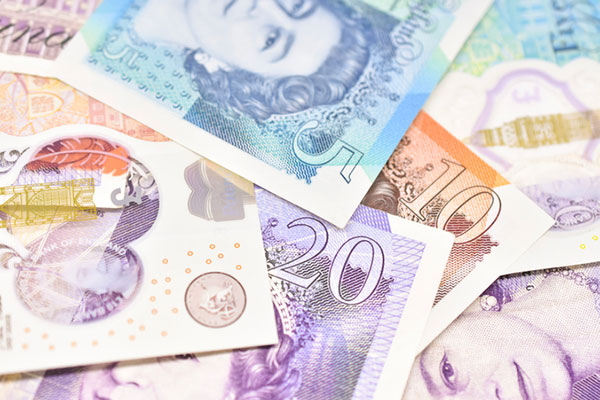Top 10 things to think about when tidying up your taxes
29th December 2021 09:44
by Faith Glasgow from interactive investor
Use the Christmas break to get you finances in order, urges Faith Glasgow, who has some great advice for anyone wanting to be as tax-efficient as possible.

While this may be the end of the calendar year rather than the tax year, the week after Christmas is also a rare period of downtime for many people who take the week off work.
It also gives you plenty of time before the April deadline to get a new regime up and running. So why not put it to good use with a spot of personal admin to ensure your finances are as tax-efficient as they can be?
1) Top up your ISA
Many people have not gone back to their pre-pandemic spending patterns, and are sitting on much more cash than they previously would have done. A recent Institute for Fiscal Studies report finds that household savings increased significantly during 2020 and remained high (at 18%) in the first half of 2021.
With bank savings rates still at historic lows, it makes sense to put to work tax-efficiently at least some cash you don’t need at this time, while keeping a cushion of say three months’ income.
One option is to make a lump sum payment into your pension, although if this is income you’ve already paid tax on and you are a higher or additional rate taxpayer, you will have to reclaim some extra tax through your tax self-assessment form.
The other involves less admin: if you have not already used your £20,000 ISA allowance, use the spare cash to top up your account and invest it. It will grow tax-free and you can access it at any time.
- Check out our award-winning stocks and shares ISA
- Friends & Family: ii customers can give up to 5 people a free subscription to ii, for just £5 a month extra. Learn more
2 Bed & ISA
Of course, your bank account may not be in tip-top shape in the aftermath of those Christmas splurges, making one-off contributions into your ISA a bit of a challenge. But you may have accumulated funds or shares over the years – through utility privatisations or building society flotations, for example – that never found their way into an ISA.
If you still have some allowance to spare, doing a Bed & ISA is a great opportunity to get them within the tax-free fold. Bed & ISA involves selling the investment from the taxable account and repurchasing it more or less simultaneously within an ISA.
It means you can see where everything is; you’ll avoid paying capital gains tax (CGT) when you sell those investments in future (although you need to be careful in the Bed & ISA transaction that your capital gains don’t exceed your annual CGT allowance); and you will no longer have to declare dividend payments on a self-assessment form.
Bed & ISA is made very easy through interactive investor, for example, with a readymade link and the broker doing the heavy lifting.
- Watch our Christmas and New Year share tips here and subscribe to the ii YouTube channel for free
- 20 best-performing funds since Junior ISA launched a decade ago
3) Use your capital gains tax allowance
Basic rate taxpayers pay capital gains tax (CGT) at 10% and higher-rate taxpayers at 20% on the profits they make from sales and other ‘disposals’ of investments held outside a tax wrapper (and also of assets such as artworks, antiques and second homes) that have gained in value since they were acquired.
However, everyone has an annual allowance of £12,300 (frozen now until 2026). This is a ‘use it or lose it’ allowance, so you can’t carry it forward to the next year if you don’t use it.
If you have ‘unwrapped’ holdings, it therefore makes sense to sell some investments up to the value of your allowance each year, to reduce the risk of a much bigger bill in the future. If you haven’t used up your ISA allowance and want to carry on owning those investments (or others), buy the holdings back within the ISA (see Bed & ISA, above).
If you’re planning to sell assets in the coming few months and the profits could exceed the allowance, there are several useful options to consider. For example, assets can be passed between spouses or civil partners without any CGT liability, so if you put an asset into your joint names before you sell it, you’ll be able to use both allowances - £24,600.
Additionally, you may be able to sell some assets, such as shares, in two tranches across two tax years, so you can use both years’ allowances.

4) Minimise dividend income tax
Some of the investments you hold outside your tax wrappers may pay dividends, which are potentially liable to dividend tax. Again, there is a personal dividend allowance that means you can earn up to £2,000 worth of dividends each tax year without having to worry about paying tax on them.
Above that threshold, tax is payable at a different rate from standard income tax. Basic-rate taxpayers pay 7.5%, rising to 32.5% and 38.1% respectively for higher-rate and additional rate taxpayers. From April next year, these rates will increase by 1.25% (ie to 8.75%, 33.75% and 39.35%) to help fund health and social care costs.
It makes sense to prioritise moving income-generating investments into a tax wrapper over those that do not pay out, because of this additional tax risk on top of CGT - and all the more so in light of the impending dividend tax hike. If you’ve used up your ISA allowance, consider switching them into investments focusing on capital growth rather than dividends.
- Top 10 things you need to know about holding cash versus investing
- Squid Game has lessons for investors
5) Another tax-efficient investment option
If you’re considering tax-efficient homes for other spare cash and have a taste for riskier investments, venture capital trusts are an interesting place to look. VCTs, or venture capital trusts, are specialist investment trusts that invest in relatively early stage businesses; you can invest up to £200,000 a year in them.
Provided the shares are new issues and you hold them for at least five years, you can claim 30% income tax relief on their value, so an investment of £100,000 in VCTs would qualify for £30,000 of tax relief. You need to have paid or owe at least that much tax during the tax year in which you invest, and will forfeit the relief if you sell within five years.
In addition, dividend payments are tax-free and there is no CGT to pay on disposals. In practice, most returns are paid through dividends, so they can be useful for income seekers.
This is the best time of year to invest, as VCT companies tend to launch new offers in the run up to the end of the tax year and may offer ‘early bird’ discounts on the initial charges during this time. Find out more on interactive investor’s VCT hub.
- Want to invest ethically? ii’s ACE 40 list of ethical investments can help
- Don't be shy, ask ii: we answer your questions
6) Watch out for frozen tax thresholds
In last April’s Budget, income tax thresholds were given a small boost (to £12,570 for basic-rate taxpayers and £50,270 for higher-rate payers) but are now frozen until 2026.
As wages rise over this period, this results in more people moving into the higher tax bracket. The Office for Budget Responsibility estimates the freezes will mean 1.3 million people start paying income tax and a million move into the higher-rate tax bracket. It’s known as fiscal drag and is a stealthy way to squeeze more tax out of people without actually raising tax rates.
One way to sidestep being sucked into a higher rate, if you’re on the threshold and concerned that an upcoming pay rise could push you over, is to channel some or all of your salary increase into your pension, where you will receive full tax relief on it.
It’s a relatively painless solution, because you never had the extra money so you don’t feel the loss. Better still, your employer may match some or all of the additional contributions. But of course you have to be able to afford to do without the extra money, at a time when inflation is on the up.

7) Pension top-ups
Even if you’re not worried about paying a higher rate of tax, it’s worth looking at your monthly pension contributions to see if there’s any scope to increase them in the run up to the end of the tax year (bearing in mind that you have an annual allowance of the lower of £40,000 or 100% of your earnings).
Increasing pension contributions is a fantastically effective way to use earnings that you’re not spending.
Not only is all the tax you would otherwise have paid on it reclaimable, but your employer may also increase its financial contribution in line with yours up to a certain level.
Employers should contribute at least 3% of your salary, but the website careersmart.org.uk suggests that the average employer contribution in a defined contribution (investment-based) occupational scheme is between 7% and 14%.
If you don’t have other plans for an end-of-year bonus, asking for it to be paid directly into your pension again means you get full tax relief on the lump sum, although you won’t get an additional employer boost.
- Read the Great British Retirement Survey 2021 report here.
- Visit our Pensions and Retirement Hub
8) Reclaim pension tax relief
You’re entitled to tax relief at the highest rate of tax you pay on pension contributions – so basic-rate taxpayers can claim 20% relief, while higher and additional rate taxpayers get 40% and 45% relief respectively. But the way you obtain this depends on the type of pension scheme you’re enrolled in.
If your workplace scheme uses a ‘net pay’ arrangement, you won’t have to do anything because your contributions are taken from your salary before it’s taxed and the pension scheme automatically claims the full amount of relief.
The alternative is a ‘relief at source’ arrangement, used by some occupational pension schemes and all personal pensions and SIPPs. Here, only basic rate tax relief is automatically reclaimed by the pension provider, and higher and additional rate taxpayers have to reclaim the extra relief through a tax return. It will be sent directly to them rather than being paid into the pension.
If you’re a higher or additional rate taxpayer, do double check with your pension provider whether you will need to reclaim the extra tax relief yourself.
- Top 10 things you need to know about your state pension
- Pension stories: examine the saving habits and goals of investors at different life stages
9) Salary sacrifice
Another wheeze for those on middle-level to higher incomes to help turbocharge their pension is what’s known as salary sacrifice. If your employer offers it, it can be a good option, but do make sure you understand how your proposed ‘sacrifice’ will affect your take-home pay.
Basically, you agree with your employer that your salary will be reduced by a certain amount, and your employer then pays the reduction and their contribution into the pension scheme.
The main attraction is that neither you nor the employer has to pay national insurance on that chunk going into the pension. Generous employers may add their saved NI contributions to your pension, although they don’t have to.
Given that the introduction of the Health and Social Care Levy means NI contributions will go up by 1.25% for employees (and employers) in April 2022, salary sacrifice looks an even more attractive option.
10) Allowances for working from home
If your employer has asked you to work at home on a regular basis since the pandemic started but hasn’t reimbursed you, one useful piece of personal admin is to claim tax relief against costs incurred while you are working. These include gas and electricity, metered water and business use of the phone and internet.
HMRC provides two alternative ways of calculating the tax relief you are due. If you have kept bills and invoices, you can claim against the exact amount by which your bills have gone up as a result of working from home.
Otherwise, for the period since April 2020 you can claim tax relief against a flat £6 per week of costs, in which case no bills are required. So a basic-rate taxpayer would be due tax relief at 20% on £6 (£1.20 per week, or £62.40 per year), while a higher-rate taxpayer could claim 40% (£2.40 per week or £125 per year).
If you do not normally complete a self-assessment form, you can make the claim via a Government Gateway account. It’s paid through an adjustment to your tax code, so you’ll pay a little less tax on your salary this tax year. But you can also claim for last tax year, in which case you’ll receive a lump sum in your salary.
Because this is an individual tax relief, both partners in a couple or all members of a shared household can make their own claims.
These articles are provided for information purposes only. Occasionally, an opinion about whether to buy or sell a specific investment may be provided by third parties. The content is not intended to be a personal recommendation to buy or sell any financial instrument or product, or to adopt any investment strategy as it is not provided based on an assessment of your investing knowledge and experience, your financial situation or your investment objectives. The value of your investments, and the income derived from them, may go down as well as up. You may not get back all the money that you invest. The investments referred to in this article may not be suitable for all investors, and if in doubt, an investor should seek advice from a qualified investment adviser.
Full performance can be found on the company or index summary page on the interactive investor website. Simply click on the company's or index name highlighted in the article.